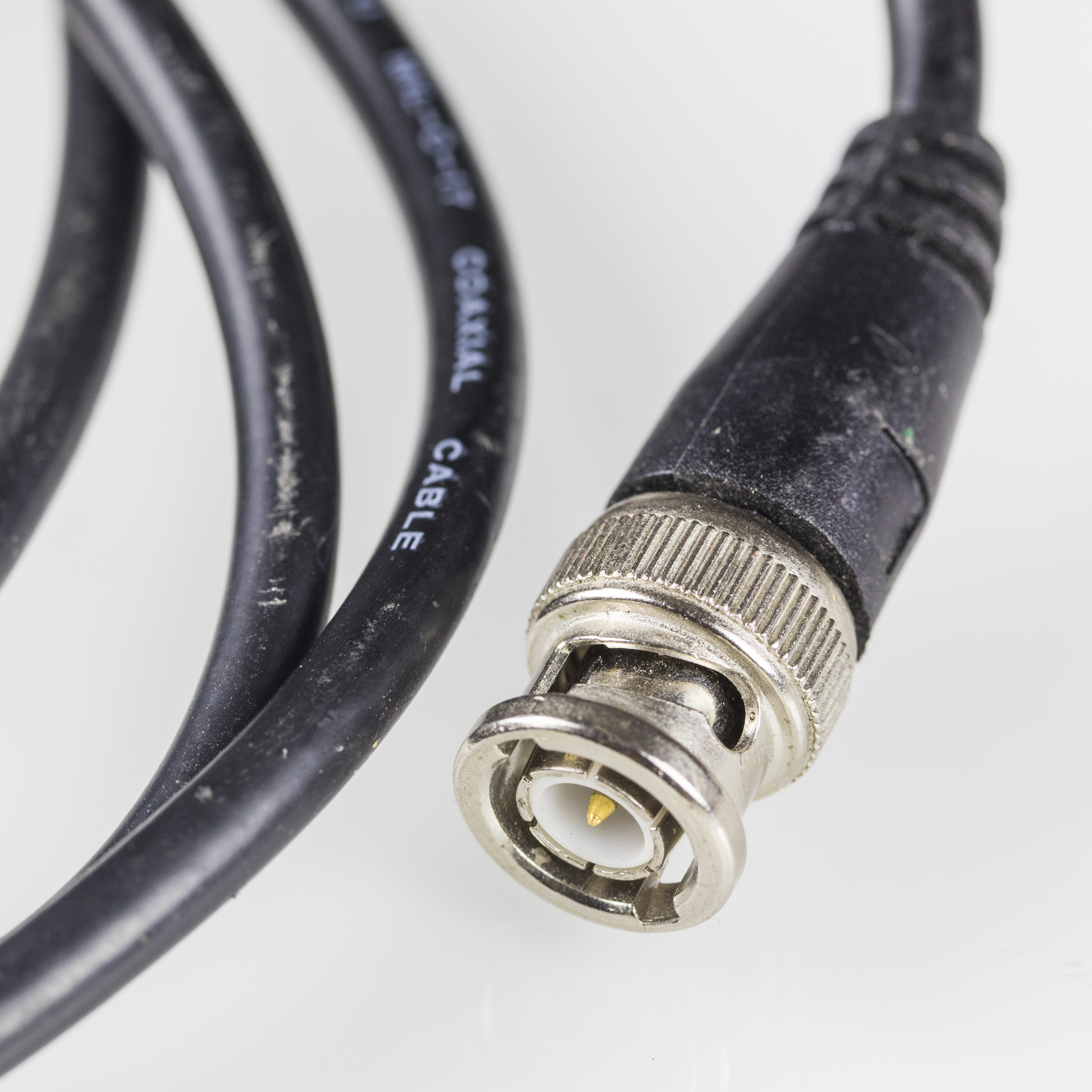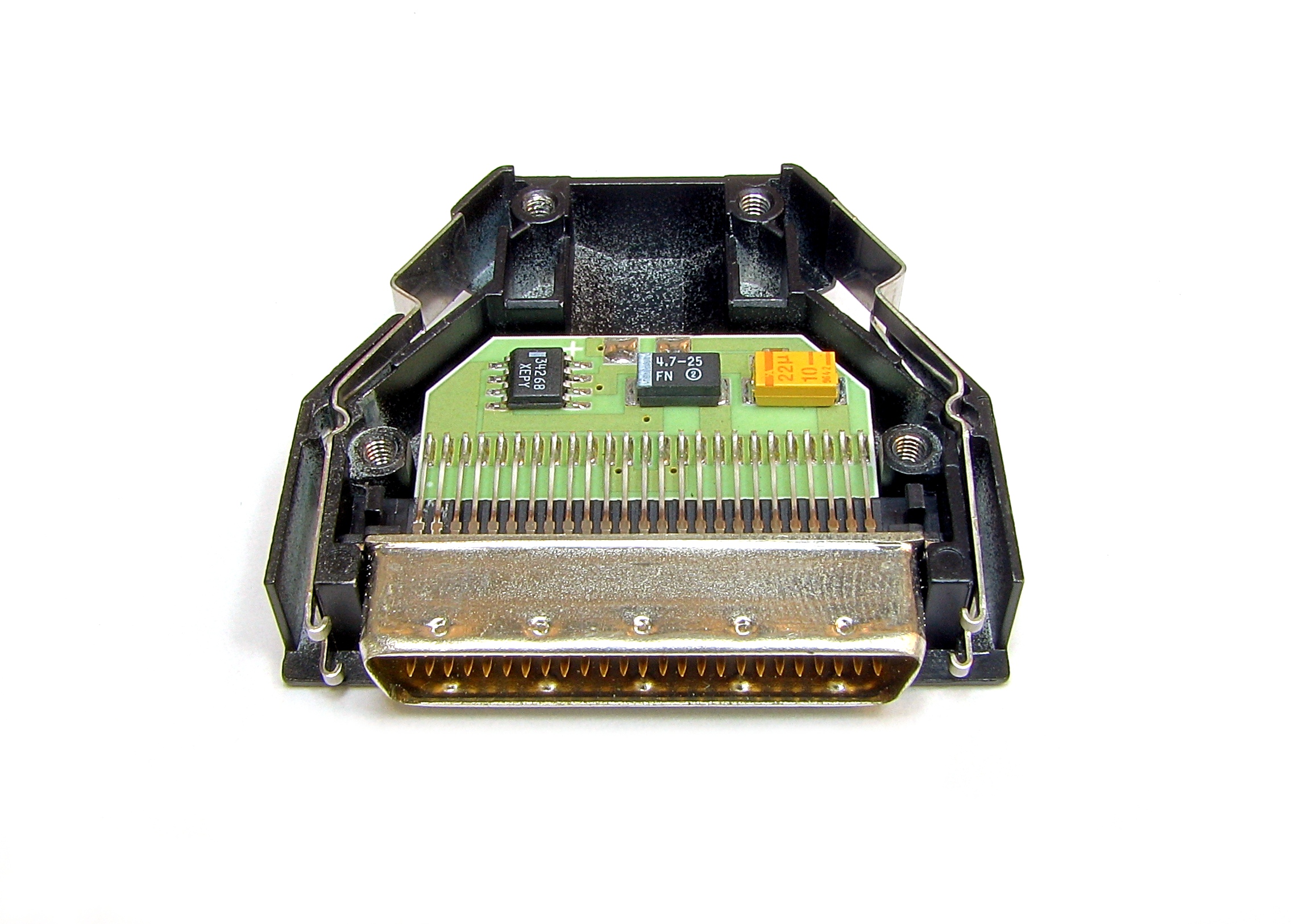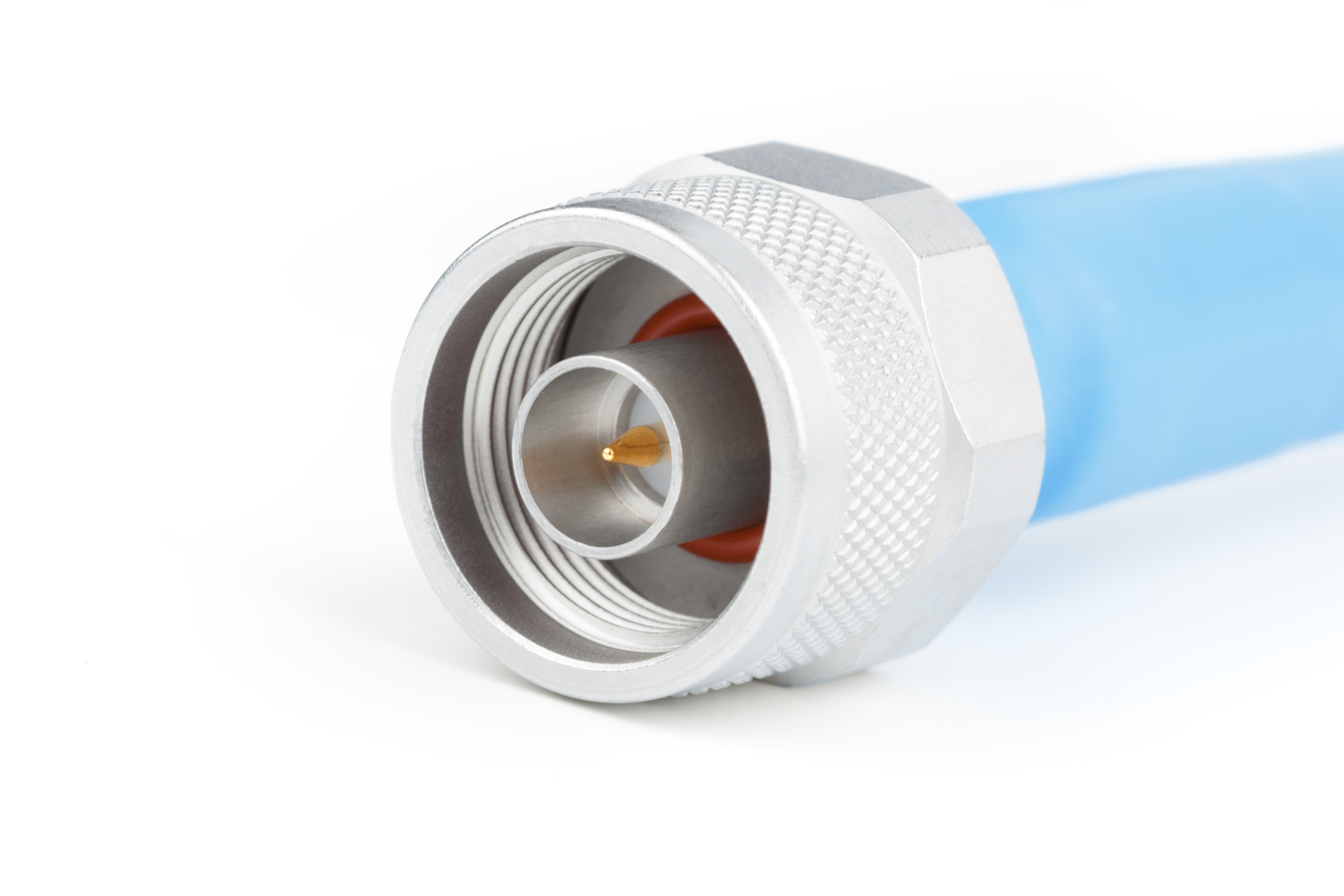|
Thicknet
10BASE5 (also known as thick Ethernet or thicknet) was the first commercially available variant of Ethernet. The technology was standardized in 1982 as IEEE 802.3. 10BASE5 uses a thick and stiff coaxial cable up to in length. Up to 100 stations can be connected to the cable using vampire taps and share a single collision domain with 10 Mbit/s of bandwidth shared among them. The system is difficult to install and maintain. 10BASE5 was superseded by much cheaper and more convenient alternatives: first by 10BASE2 based on a thinner coaxial cable, and then, once Ethernet over twisted pair was developed, by 10BASE-T and its successors 100BASE-TX and 1000BASE-T. In 2003, the IEEE 802.3 working group deprecated 10BASE5 for new installations. Name origination The name ''10BASE5'' is derived from several characteristics of the physical medium. The ''10'' refers to its transmission speed of 10 Mbit/s. The ''BASE'' is short for baseband signaling (as opposed to broadband), an ... [...More Info...] [...Related Items...] OR: [Wikipedia] [Google] [Baidu] |
10BASE2
10BASE2 (also known as cheapernet, thin Ethernet, thinnet, and thinwire) is a variant of Ethernet that uses thin coaxial cable terminated with BNC connectors to build a local area network. During the mid to late 1980s this was the dominant 10 Mbit/s Ethernet standard, but due to the immense demand for high-speed networking, the low cost of Category 5 cable, and the popularity of 802.11 wireless networks, both 10BASE2 and 10BASE5 have become increasingly obsolete, though devices still exist in some locations. As of 2011, IEEE 802.3 has deprecated this standard for new installations. Name origination The name ''10BASE2'' is derived from several characteristics of the physical medium. The ''10'' comes from the transmission speed of 10 Mbit/s. The ''BASE'' stands for baseband signaling, and the ''2'' for a maximum segment length approaching 200 m (the actual maximum length is 185 m). Signal encoding 10 Mbit/s Ethernet uses Manchester coding. A binary ze ... [...More Info...] [...Related Items...] OR: [Wikipedia] [Google] [Baidu] |
Vampire Tap
A vampire tap (also called a piercing tap) was a device for physically connecting a station, typically a computer, to a network that used 10BASE5 cabling. This device clamped onto and "bit" into the cable (hence the name "vampire"), inserting a probe through a hole drilled using a special tool through the outer shielding to contact the inner conductor, while other spikes bit into the outer conductor. The vampire tap usually had an integrated AUI (Attachment Unit Interface), from which a short multicore cable connected to the network card in the station. Vampire taps allowed new connections to be made on a given physical cable while the cable was in use. This allowed administrators to expand bus topology network sections without interrupting communications. Without a vampire tap, the cable had to be cut and connectors had to be attached to both ends. See also *Network tap *Insulation-displacement connector An insulation-displacement contact (IDC), also known as insulatio ... [...More Info...] [...Related Items...] OR: [Wikipedia] [Google] [Baidu] |
Coaxial Cable
Coaxial cable, or coax (pronounced ) is a type of electrical cable consisting of an inner conductor surrounded by a concentric conducting shield, with the two separated by a dielectric ( insulating material); many coaxial cables also have a protective outer sheath or jacket. The term ''coaxial'' refers to the inner conductor and the outer shield sharing a geometric axis. Coaxial cable is a type of transmission line, used to carry high-frequency electrical signals with low losses. It is used in such applications as telephone trunk lines, broadband internet networking cables, high-speed computer data busses, cable television signals, and connecting radio transmitters and receivers to their antennas. It differs from other shielded cables because the dimensions of the cable and connectors are controlled to give a precise, constant conductor spacing, which is needed for it to function efficiently as a transmission line. Coaxial cable was used in the first (1858) and followin ... [...More Info...] [...Related Items...] OR: [Wikipedia] [Google] [Baidu] |
Passband
A passband is the range of frequencies or wavelengths that can pass through a filter. For example, a radio receiver contains a bandpass filter to select the frequency of the desired radio signal out of all the radio waves picked up by its antenna. The passband of a receiver is the range of frequencies it can receive when it is tuned into the desired frequency (channel). A bandpass-filtered signal (that is, a signal with energy only in a passband), is known as a bandpass signal, in contrast to a baseband signal. Filters In telecommunications, optics, and acoustics, a passband (a band-pass filtered signal) is the portion of the frequency spectrum that is transmitted (with minimum relative loss or maximum relative gain) by some filtering device. In other words, it is a ''band'' of frequencies which ''pass''es through some filter or a set of filters. The accompanying figure shows a schematic of a waveform being filtered by a bandpass filter consisting of a highpass and a low ... [...More Info...] [...Related Items...] OR: [Wikipedia] [Google] [Baidu] |
Classic Ethernet
Classic Ethernet is a family of 10 Mbit/s Ethernet standards, which is the first generation of Ethernet standards. In 10BASE-X, the 10 represents its maximum throughput of 10 Mbit/s, BASE indicates its use of baseband transmission, and X indicates the type of medium used. Varieties Fibre-based standards (10BASE-F) ''10BASE-F'', or sometimes ''10BASE-FX'', is a generic term for the family of 10 Mbit/s Ethernet standards using fiber optic cable. In 10BASE-F, the 10 represents a maximum throughput of 10 Mbit/s, BASE indicates its use of baseband transmission, and F indicates that it relies on medium of fiber-optic cable. The technical standard requires two strands of 62.5/125 µm multimode fiber. One strand is used for data transmission while the other is used for reception, making 10BASE-F a full-duplex technology. There a three different variants of 10BASE-F: 10BASE-FL, 10BASE-FB and 10BASE-FP. Of these only 10BASE-FL experienced widespread use. With ... [...More Info...] [...Related Items...] OR: [Wikipedia] [Google] [Baidu] |
Carrier-sense Multiple Access With Collision Detection
Carrier-sense multiple access with collision detection (CSMA/CD) is a medium access control (MAC) method used most notably in early Ethernet technology for local area networking. It uses carrier-sensing to defer transmissions until no other stations are transmitting. This is used in combination with collision detection in which a transmitting station detects collisions by sensing transmissions from other stations while it is transmitting a frame. When this collision condition is detected, the station stops transmitting that frame, transmits a jam signal, and then waits for a random time interval before trying to resend the frame. CSMA/CD is a modification of pure carrier-sense multiple access (CSMA). CSMA/CD is used to improve CSMA performance by terminating transmission as soon as a collision is detected, thus shortening the time required before a retry can be attempted. With the growing popularity of Ethernet switches in the 1990s, IEEE 802.3 deprecated Ethernet repeaters in 2 ... [...More Info...] [...Related Items...] OR: [Wikipedia] [Google] [Baidu] |
Electrical Termination
In electronics, electrical termination is the practice of ending a transmission line with a device that matches the characteristic impedance of the line. Termination prevents signals from reflecting off the end of the transmission line. Reflections at the ends of unterminated transmission lines cause distortion which can produce ambiguous digital signal levels and mis-operation of digital systems. Reflections in analog signal systems cause such effects as video ghosting, or power loss in radio transmitter transmission lines. Transmission lines Signal termination often requires the installation of a terminator at the beginning and end of a wire or cable to prevent an RF signal from being reflected back from each end, causing interference, or power loss. The terminator is usually placed at the end of a transmission line or daisy chain bus (such as in SCSI), and is designed to match the AC impedance of the cable and hence minimize signal reflections, and power losses. Less com ... [...More Info...] [...Related Items...] OR: [Wikipedia] [Google] [Baidu] |
IEEE
The Institute of Electrical and Electronics Engineers (IEEE) is a 501(c)(3) professional association for electronic engineering and electrical engineering (and associated disciplines) with its corporate office in New York City and its operations center in Piscataway, New Jersey. The mission of the IEEE is ''advancing technology for the benefit of humanity''. The IEEE was formed from the amalgamation of the American Institute of Electrical Engineers and the Institute of Radio Engineers in 1963. Due to its expansion of scope into so many related fields, it is simply referred to by the letters I-E-E-E (pronounced I-triple-E), except on legal business documents. , it is the world's largest association of technical professionals with more than 423,000 members in over 160 countries around the world. Its objectives are the educational and technical advancement of electrical and electronic engineering, telecommunications, computer engineering and similar disciplines. History Origin ... [...More Info...] [...Related Items...] OR: [Wikipedia] [Google] [Baidu] |
Node (networking)
In telecommunications networks, a node (, ‘knot’) is either a redistribution point or a communication endpoint. The definition of a node depends on the network and protocol layer referred to. A physical network node is an electronic device that is attached to a network, and is capable of creating, receiving, or transmitting information over a communication channel. A passive distribution point such as a distribution frame or patch panel is consequently not a node. Computer networks In data communication, a physical network node may either be data communication equipment (DCE) such as a modem, hub, bridge or switch; or data terminal equipment (DTE) such as a digital telephone handset, a printer or a host computer. If the network in question is a local area network (LAN) or wide area network (WAN), every LAN or WAN node that participates on the data link layer must have a network address, typically one for each network interface controller it possesses. Examples are compu ... [...More Info...] [...Related Items...] OR: [Wikipedia] [Google] [Baidu] |
N Connector
The N connector (also, type-N connector) is a threaded, weatherproof, medium-size RF connector used to join coaxial cables. It was one of the first connectors capable of carrying microwave-frequency signals, and was invented in the 1940s by Paul Neill of Bell Labs, after whom the connector is named. Design The interface specifications for the N and many other connectors are referenced in MIL-STD-348. Originally, the connector was designed to carry signals at frequencies up to 1 GHz in military applications, but today's common Type N easily handles frequencies up to 11 GHz. More recent precision enhancements to the design by Julius Botka at Hewlett Packard have pushed this to 18 GHz. The male connector is hand-tightened (though versions with a hex nut are also available) and has an air gap between the center and outer conductors. The coupling has a -24 UNEF thread. Amphenol suggests tightening to a torque of , while Andrew Corporation suggest for their hex nut ... [...More Info...] [...Related Items...] OR: [Wikipedia] [Google] [Baidu] |
Transceiver
In radio communication, a transceiver is an electronic device which is a combination of a radio ''trans''mitter and a re''ceiver'', hence the name. It can both transmit and receive radio waves using an antenna, for communication purposes. These two related functions are often combined in a single device to reduce manufacturing costs. The term is also used for other devices which can both transmit and receive through a communications channel, such as ''optical transceivers'' which transmit and receive light in optical fiber systems, and ''bus transceivers'' which transmit and receive digital data in computer data buses. Radio transceivers are widely used in wireless devices. One large use is in two-way radios, which are audio transceivers used for bidirectional person-to-person voice communication. Examples are cell phones, which transmit and receive the two sides of a phone conversation using radio waves to a cell tower, cordless phones in which both the phone handset and ... [...More Info...] [...Related Items...] OR: [Wikipedia] [Google] [Baidu] |





